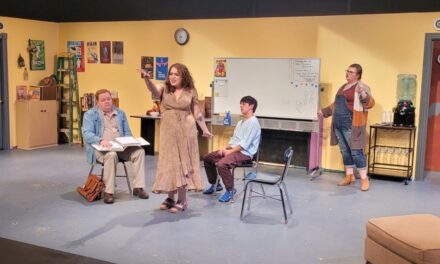Interview by Scott Dowd
Based on the 2000 Academy Award-nominated film of the same title, Billy Elliot the Musical is the story of a young boy from a depressed working-class mining town in the North of England. Set during the 1984 miners’ strike, a seminal moment in British history, the show follows Billy, the youngest child of a blue-collar family, as he discovers his extraordinary gift for ballet. While Billy’s father and brother take to the picket lines, Billy secretly begins to study the art of dance with the help of a hard-drinking, chain-smoking local dance teacher. But as Billy thrives, the lives around him wither – and his only escape may be the prestigious Royal Ballet School, a place no working-class boy has ever gone, or been allowed to go, before.
Although Billy Elliot is film director Stephen Daldry’s first musical, Daldry – along with choreographer Peter Darling, Sir Elton John (who provides the musical score for the stage adaptation), and the entire Tony Award-winning creative team – approached this production in the same way they did when creating the original film version more than a decade ago. Former Radio City Rockette Mary Giotinno serves as associate choreographer for the show and dance supervisor for the touring production. Working out of New York City, Mary has spent much of the past five years helping the young dancers who portray Billy achieve their dreams of becoming professional performers.
 |
| Mary Giottino. Photo by Doug Blemker. |
SD: When did you become affiliated with Billy Elliot the Musical?
MG: I started with the Broadway company and I was the tap teacher in the Billy Camp. There was a Billy Camp and a Michael Camp, and I gave maintenance tap classes to the boys in the show and helped train-up future boys coming into one of the three productions.
SD: How long did you do that?
MG: I did it for about a year there and spent the last year and a half traveling with the second national tour. Then I set the version of the show that is coming to Louisville. I taught the dancers and the assistant choreographer, Kate Dunn. And now I’m in New York supervising all of the dance aspects of the show.
SD: Tell me about this version of the show. How is it different from the others?
MG: To tell you the truth, they’re all about the same. The dances are the same in all four companies. There are differences from the London version to the American version, and this one has its own unique qualities. The version coming to Louisville is the same one we did in Chicago, on the second national tour and on Broadway.
SD: On your web site, there are a lot of pictures of you working with the kids. How many are in the show?
 |
|
|
MG: It is quite the group. We have four boys playing the role of Billy. They each do two shows per week. We have two boys playing the role of Michael, Billy’s best friend. They do a sensational tap dance together in act one – it’s really a Broadway extravaganza. Then there are the nine ballet girls in Billy’s ballet class and one boy who plays Small Boy – that’s his name, Small Boy. So there are sixteen kids on tour.
SD: This is a show about dance, so it must be difficult to find the right children for these roles. Not only do they have to be able to act, but they have to dance!
MG: That’s the number-one requirement. A boy can’t get in the show as Billy without a dance background. Small Boy doesn’t have to dance, and Michael has his own set of criteria. But all of the other children come in with a background in dance. All of these children dance extensively in the show, with Billy having the most, of course. Nora Brennan, our children casting director, does an incredible job. She goes out two or three times a year specifically looking for Billys.
SD: How far does she expand the search?
MG: We’ve had Billys from all over the country and many countries around the world. Right now, one of our Billys is Canadian and the other three are American. That’s unusual. Last year we had two Australians and a Japanese child. It’s such a difficult role to cast, and Nora starts tracking these boys from when they’re about nine or ten years old. By the time they get the roles, they’re eleven or twelve and they’re in the show for about a year.
SD: Only a year?
MG: That’s the average. J.P. has been in the show for over two years now. That’s incredible really.
SD: Sure. If nothing else, they will age out of the role.
MG: Exactly. Some boys do that really quickly. There are so many variables we live with in Billy; we never know when a boy will grow an inch overnight, or their voice just drops. It’s that whole puberty thing and, of course, we’re hiring boys who are that age.
SD: What is life like on the road for these kids?
MG: The training they’ve gone through to get in continues in rehearsal. By the time any given boy reaches opening night, he may have spent two years in training.
SD: Sounds like a microcosm of a dancer’s life. You mentioned that the search process for Michael is a little different. How so?
MG: Nine out ten Michaels come to us with zero dance background. We really love hiring unique, fun characters – kids you would never imagine breaking into a tap dance. Once they’re in the show – Billys and Michaels specifically – they have extensive one-to-one acting training every day. They have dialect coaching, because the boys are all speaking with a Geordie accent from the North of England. That takes weeks of hard work to learn; and most of these boys, especially those playing Billy, have never done anything but dance. It’s very rare we get a boy who has done a musical before or who has sung before. So here they are, never having spoken a single line of dialogue much less five hundred lines, in front of thousands of people every night!
SD: Not to mention they are carrying the emotional weight of the show.
MG: You know Billy carries the weight of the entire production. The show runs about two hours and fifty minutes, and Billy is on stage for two hours and forty minutes. There are a couple of short scenes in Act II when he’s off stage between his dream ballet, which has an extensive pas de deux with his older self, and the “eleven o’clock number,” Electricity.
SD: I imagine even two shows a week is a challenge.
MG: We space them out in performance, but they’re not off. When they’re not on stage, they have massage and physiotherapy; there is core and cardio training; there is a rehearsal where they go through their entire show with notes from the resident director and choreographer; and they have a show where they stand by. It has happened that one boy will go out mid-show and the other boy goes on stage.
SD: At least you have someone who is really prepped and ready.
MG: Absolutely. The resident company and stage management do a great job of making sure each boy has enough down time and can still be ready in case of emergency. They are in the theatre four times a week, and when they’re not, they’re rehearsing.
SD: And going to school?
MG: Every day. Three tutors travel with the show and they make sure the children keep pace with the curriculum – whether it’s a home-school program, public school, private school – whatever is normative for that child, including all of the state testing, etc.
SD: The logistics of having children on the road is a huge challenge!
MG: It really takes a village there and here in New York to make this happen. The people on the road with them do an amazing job every day making sure these children are well-cared for and having fun because, at the end of the day, they’re kids. If we’re in Minneapolis, they want to go to the Mall of America and we make that happen. In Washington, D.C., they all got to go to the White House and waved to president Obama, who they happened to see on the lawn. We look for an academic field trip in every city.
SD: The Kentucky Center is just down the street from Louisville’s Museum Row.
MG: The kids would love that!
SD: This show is about the social pressures affecting boys who want to become dancers. It’s set in the 1980s. But have things changed in that regard?
MG: I wish I could say it isn’t an issue any longer, but it is. But it’s better. There are so many shows on television now that expose Americans to dance – I’m really grateful for that. We’re seeing that there are a lot of guys who dance, and it’s okay if my son wants to pursue it. It’s much better than it was in 1984 when the story takes place. Billy faces the additional obstacle that he is in a miners’ town that is pretty utilitarian. They don’t have much appreciation for the arts – especially during a strike.
SD: There is a lot of subtext in the story that has to do with Margaret Thatcher and Parliament. Does that translate well for American audiences, many of whom weren’t even born when the Iron Lady was in Number 10 Downing Street?
MG: We have banners outside the theatre explaining the context of the show and what is happening in Durham County in 1984. We hope people will read that, as it really establishes the play in their minds. We don’t expect everyone to understand what was happening in England at that time, but the show is written so well that audiences will get it. There is a big anti-Thatcher scene in the opening of Act II with a huge puppet of Margaret Thatcher. Just by the activity on stage, you understand how the characters feel about her. The show does a great job without hitting you over the head. But even if you don’t understand a word they’re saying or have no idea what the subtext is about, this show will hook you as soon as they start to dance. As soon as you meet Billy, you understand everything you need to know about this show, because it’s really all about him!
You can see Billy Elliot the Musical in Whitney Hall June 26-July 1. Ticket prices start at $22.75 and are available at the box office, 502.584.7777 or kentuckycenter.org. For more information on this show and the season, go to BroadwayInLouisville.com.




